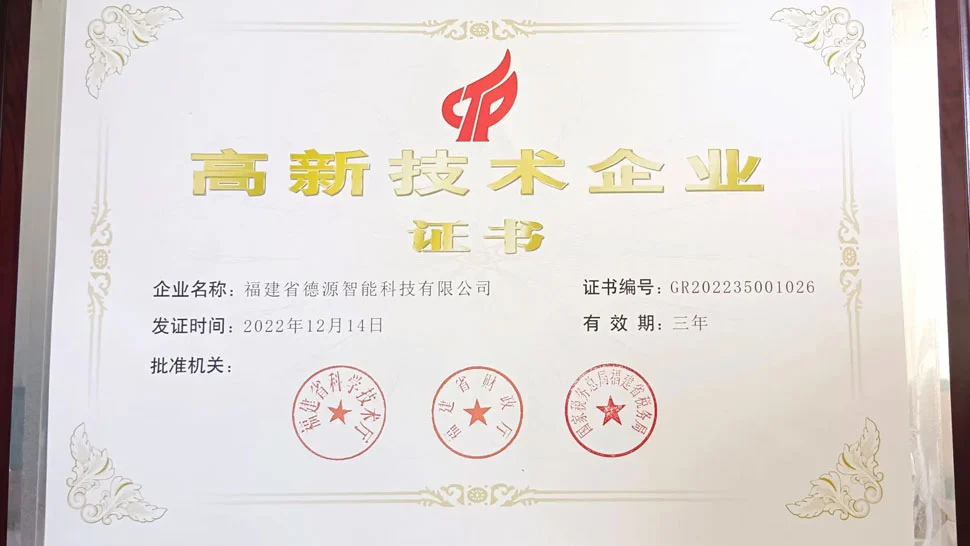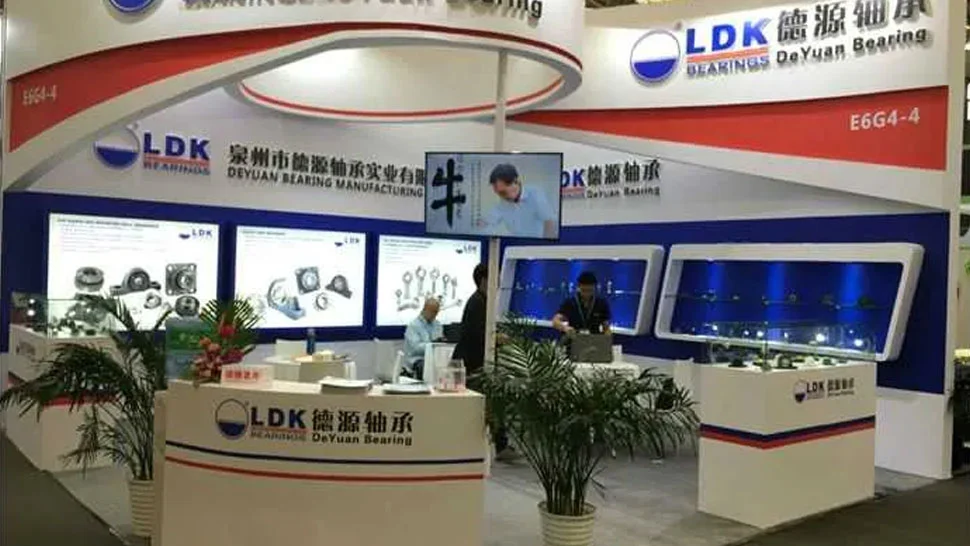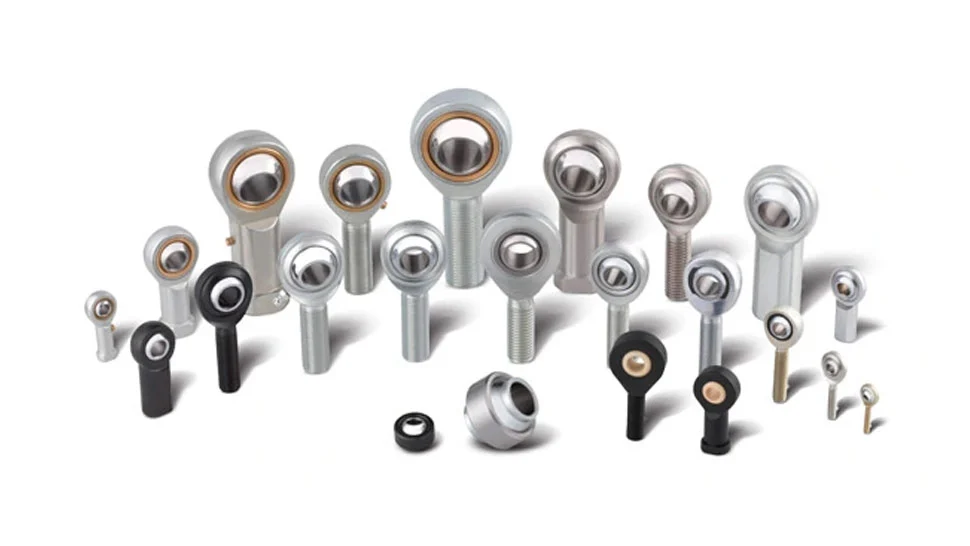LDK radial spherical plain bearings have an inner ring with a spherical outside surface and an outer ring with a correspondingly spherical but concave inside surface.Their design makes them particularly suitable for bearing arrangements where alignment movements between shaft and housing have to be accommodated,or where oscillating or recurrent tilting or slewing movements must be permitted at relatively slow sliding speeds. LDK radial spherical plain bearings are available with different sliding contact surface combinations,i.e.the sliding surfaces of inner and outer rings are made from different materials.There are two main groups:spherical plain bearings requiring maintenance(steel-on-steel)and maintenance- free spherical plain bearings.
LDK radial spherical plain bearings requiring maintenance (steel-on-steel)have hardened sliding contact surface on both rings.The surfaces are treated with molybdenum disulphide and phosphated. It has characteristics of wear-resistance and wear-corrosion.Bearings with this sliding contact surface combination require regular relubrication.The high strength of the sliding contact surfaces makes these bearings especially suitable for bearing arrangements where heavy loads of alternating direction,shock loads or heavy static loads have to be accommodated.
LDK maintenance-free spherical plain bearing sliding contact surfaces have three groups: Steel-on-PTFE composite material, Steel-on-PTFE fabric and steel-on-copper alloy.Dynamic load support capability of Steel-on-PTFE fabric spherical plain bearings is higher than that of Steel-on-PTFE composite material.They have very low friction and can be operated without maintenance.They are used for applications where long bearing lives are required without maintenance,or where operating conditions,such as inadequate lubrication or the absence of lubrication make the use of steel-on-steel bearing inadvisable.
The sphered sliding contact surfaces of angular contact spherical plain bearings are inclined at an angle to the bearing axis.They are therefore particularly suitable for carrying combined (radial and axial)loads.A single angular contact spherical plain bearing can only accept axial loads acting in one direction.Under radial loads,a force acting in the axial direction is produced in the bearing which must always be opposed by an equal force acting in the opposite direction.Therefore,the bearings are usually adjusted against a second bearing.When two angular contact spherical plain bearings are arranged so that their sphere centres coincide,a clearance-free radial spherical plain bearing is obtained which can accommodate heavy radial loads as well as heavy axial loads in both directions.LDK angular contact spherical plain bearings are available with different sliding contact surface combinations,i.e.the sliding surfaces of inner and outer rings are made from different materials.There are two main groups :steel-on-steel angular contact spherical plain bearings and maintenance-free angular contact spherical plain bearings.
LDK steel-on-steel angular contact spherical plain bearings are made of carbon chromium steel and are hardened and phosphated,it has characteristics of wear-resistance and wear-corrosion.The inner and outer rings sliding contact surface are treated with molybdenum disulphide.Bearings with this sliding contact surface combination require regular relubrication. To facilitate efficient lubrication,outer ring has an annular groove and two lubrication holes.The high strength of the sliding surfaces makes these bearings especially suitable forbearing arrangements where heavy loads alternating direction, shock loads or heavy static loads have to be accommodated.
LDK maintenance-free angular contact spherical plain bearings have sliding contact surface combinations steel-on-PTFE fabric,they have very low friction and can be operated without maintenance,any lubrication of the sliding contact surfaces will shorten bearing life.They are used for applications where long bearing lives are required without maintenance,or where operating conditions,such as inadequate lubrication or the absence of lubrication make the use of steel-on-steel bearing inadvisable.The maintenance-free bearings are primarily intended for applications where loads are heavy and have a constant direction.
LDK Spherical plain thrust bearings have sliding contact surfaces in the shaft and housing washers which are arranged at an angle to the bearing axis.They are primarily intended for axial loads although they can accommodate combined loads to a certain extent.LDK spherical plain thrust bearings are available with different sliding contact surface combinations, i.e. the sliding surfaces of shaft and housing washers are made from different materials. There are two main group: steel-on-steel spherical plain thrust bearings and maintenance-free spherical plain thrust bearings.
LDK steel-on-steel spherical plain thrust bearings are made of carbon chromium steel and are hardened and phosphated, the shaft and housing washers sliding contact surface are treated with molybdenum disulphide,it has characteristics of wear-resistance and wear-corrosion.Bearings with this sliding contact surface combination require regular relubrication. To facilitate efficient lubrication,housing washer have an annular groove and a lubrication hole.The high wear resistance of the sliding surfaces makes these bearings especially suitable forbearing arrangements where heavy loads of alternating direction,shock loads or heavy static loads have to be accommodated.
LDK maintenance-free spherical plain thrust bearings have sliding contact surface combinations steel-on-PTFE fabrics they have very low friction and can be operated without maintenance,any lubrication of the sliding contact surfaces will shorten bearing life.They are used for applications where long bearing lives are required without maintenance,or where operating conditions,such as inadequate lubrication or the absence of lubrication make the use of steel-on-steel bearing inadvisable.The maintenance-free bearings are primarily intended for applications where loads are heavy and have a constant direction.
LDK Rod ends and Spherical Plain bearings can be operated within the operating temperatures listed below:
Mating surfaces | Temperature Celsius | Temperature Fahrenheit |
Steel/Special Brass | -50° to +200° | -58° to +392° |
Steel/Bronze | -50° to +230° | -58° to +446° |
Steel/PTFE liner | -50° to +200° | -58° to +392° |
Steel/PTFE Glass fibre liner | -30° to +150° | -22° to +302° |
Steel/Steel | -50° to +200° | -58° to +392° |
Increase of operating temperature occurs a decrease of load capacity of the bearing therefore life will be reduced too. LDK can manufacture Rod ends and Spherical Plain bearings at a wider and higher temperature range according to customer's special request.
Dynamic Rating is used for calculations when the spherical plain bearing is subjected to dynamic stress.It represents the load,constant in magnitude and direction,under which a basic rating service life,expressed as a sliding distance,will be attained for continuous oscillating movement at a defined sliding velocity and at room temperature.It presupposes that
the load acting on radial and angular spherical plain bearings and on rod ends is purely radial and that the load acting onspherical plain thrust bearings is purely axial and acts centrically. Dynamic stresses occur when tiling, oscillatory or rotational movements are made under load as well as micro sliding movements under alternating loads,e.g resulting from vibration, or loads which alternate at high frequency.The various types of dynamic stress often occur in combination.
The values of load ratings are always dependent on the definition used.It is therefore not always possible to make direct comparisons with load ratings published by other manufactures.
The static load ratings is used when spherical plain bearings standstill under load(or make occasional alignment movements) and it should also be considered when dynamically loaded bearings are subjected to heavy shock loads.The static load rating represents the load which can betaken up by a spherical plain bearing when static contact stress of bearing contact surface reaches the material stress limit.It is valid at room temperature and it is presupposed that surrounding components prevent deformation of the bearing.At higher temperature,the static load rating must be multiplied by a temperature factor, depend on the sliding contact combination.The temperature factor is the same as for dynamically stressed bearing.It is also necessary to take into consideration the permissible temperature rang for the various sliding contact surface combinations.
For rod ends, it is the strength of the rod end housing under stationary load which is considered.The rod end static load ratings give a safety factor of 1.2 times the tensile strength of the rod end housings material.
The ultimate radial static load rating is measured as the failure point when a load is increasingly applied to a pin through the rod end's bore and pulled straight up while the rod end is fixed. Note that LDK's cataloged radial load ratings include a safety factor,and that insertion of a grease fitting into the radius of the rod end may reduce the load rating due to lesser cross-sectional material in the stressed point.
The actual rating is determined by calculating the lowest of the following three values:
Race material compressive strength (R value): R=E x T x X
Rod end head strength (H Value,cartridge type construction):

Angle of T/D expressed in radians
Shank strength(S Value) Male threaded rod end:S=[(root diameter of thread² x.78)-(N² x.78)] x X
Female threaded rod end: S₁ =[(J²x.78)+(major diameter of thread² x .78)] x X
Where: E=Ball Diameter
T=Housing Width
X=Allowable Stress (See Table Below)
D=Head Diameter
N=Diameter of Drilled Hole in Shank of Male Rod End
J=Shank Diameter of Female Rod End
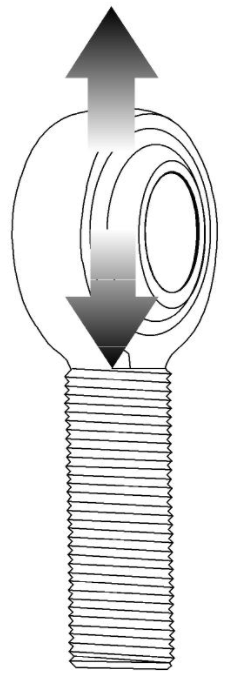
The axial static load capacity is measured as the force required to cause failure via a load parallel to the axis of the bore. Depending on material types and construction methods,the ultimate axial load is generally10-20% of the ultimate radial static load. The formula does not account for the bending of the shank due to a moment of force, nor the strength of the stake in cartridge-type construction.
AXIAL STRENGTH (A Value): A=.78 [ ( E+.176T)²-E2] × X
Where: X=Allowable Stress (See Table)
E=Ball Diameter
T=Housing Width
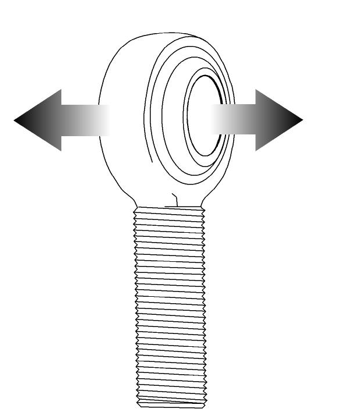
| MATERIAL | ALLOWABLE STRESS (PSI) |
| Brass | 30,000 |
| Aluminum | 35,000 |
| 300 Series Stainless Steel | 35,000 |
| low Carbon Steel | 52,000 |
| Alloy Steel | 140,000 |
The service life of the spherical plain bearings and rod ends operated under mixed or dry friction conditions is determined by the increase in bearing clearance or bearing friction caused by progressive wear of the sliding surfaces,plastic deformation of the sliding material or fatigue of the sliding surface.Depending on the application,the permissible wear or permissible increase in friction will be different.This means that under the same operating conditions the service life which can be obtained in practice will be different.
The service life of a spherical plain bearing is the number of oscillating movements,or the number of operating hours,which the bearing will service before a defined increase in bearing clearance or a defined increase in friction is reached.
The effective service life is that life which will be attained by a given spherical plain bearing under actual operating conditions. It is determined by the magnitude an type of load,but also by several other factors,such as contamination,corrosion, high-frequency load and movement cycles,shock etc.Some of these factors are impossible to determine or can only be determined with difficulty.
The maximum angel of the ball in a rod end or spherical bearing that can be maintained without interference is calculated as the angle of misalignment.It is defined as the angle between the ball center line and the outer member center line when the ball is aligned in its extreme position as allowed.The worst case limiting angle is determined by clevis mounted assembly as seen in Figure 1.Total misalignment under this condition,as cataloged by LDK for rod end applications,is twice the angle from one side of center to the opposite extreme position.Misalignment in a spherical bearing is limited by ball and race width,as functions of ball diameter,and is illustrated in Figure 3 on the right.This calculation is the basis for LDK catalogue angles of misalignment. Other mounting arrangements as shown in Figures 2-4 can also be used as guidelines in calculating the precise angle of misalignment depending on the mounting configuration,and are frequently referenced for metric usage.
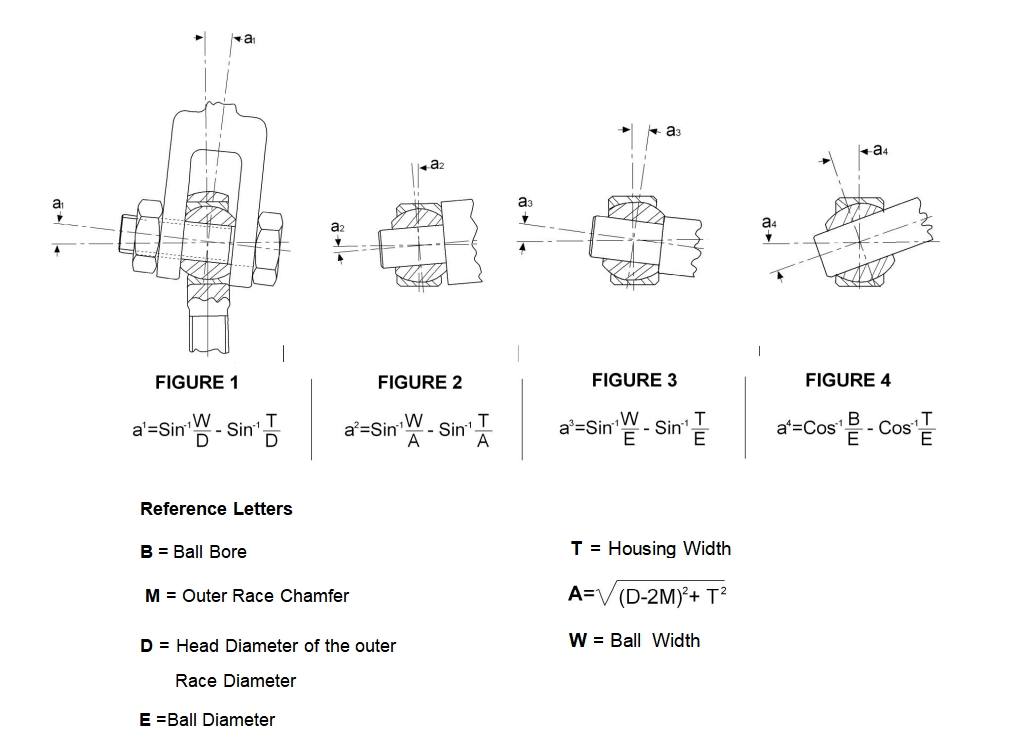
If an adequate operating life is to be achieved, a basic requirement is that the bearing contact pressure is compatible with the operating conditions. The bearing contact pressure identifies the surface pressure occurring in the bearing and is a decisive criterion for the assessment of a spherical plain bearing in each individual application.
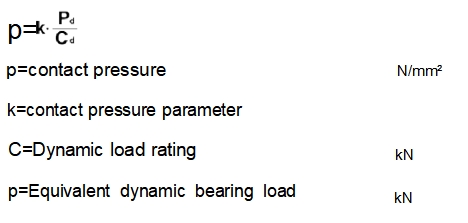
Contact surface combination | Value of load ratio Ca/P | Load factor k |
Steel/steel | 2 | 100 |
Steel/brone | 2 | 50 |
Steel/PTFE fabric | 1.75 | 150 |
Steel/PTFE composite material | 2 | 100 |
Steel/copper alloy | 2 | 100 |
Inner ring (except for series GEBK…S*, GE…PW*) (μm)
d mm | △ dmp | △ dmp* | Vdp | Vdmp | Vdp * |
Vdmp * | △ Bs | △ Bs * | |||||
over | Incl. | max | min | max | min | max | max | max | max | max | min | max | min |
-- | 18 | 0 | -8 | +18 | 0 | 8 | 6 | 18 | 14 | 0 | -120 | 0 | -180 |
18 | 30 | 0 | -10 | +21 | 0 | 10 | 8 | 21 | 16 | 0 | -120 | 0 | -210 |
30 | 50 | 0 | -12 | +25 | 0 | 12 | 9 | 25 | 19 | 0 | -120 | 0 | -250 |
50 | 80 | 0 | -15 | +30 | 0 | 15 | 11 | 30 | 22 | 0 | -150 |
0 |
-300 |
80 |
120 |
0 |
-20 |
+35 |
0 | 20 | 15 | 35 | 26 |
0 |
-200 |
0 |
-350 |
120 | 180 | 0 | -25 | +40 | 0 | 25 | 19 | 40 | 30 | 0 | -250 |
0 | -400 |
180 | 250 | 0 | -30 | +46 | 0 | 30 | 23 | 46 | 35 |
0 | -300 |
0 | -460 |
250 | 315 | 0 | -35 | +52 | 0 | 35 | 26 | 52 | 39 | 0 | -350 |
0 | -520 |
315 | 400 |
0 | -40 | +57 | 0 | 40 | 30 | 57 | 43 | 0 | -400 | 0 | -570 |
400 | 500 | 0 | -45 | 45 | 34 | 0 | -450 | ||||||
500 | 630 | -50 | 50 | 38 |
0 | -500 |
- | ||||||
The deviations in the columns with symbol*apply to spherical plain bearings of series of GEEW…ES.
Outer ring (μm)
D mm | △ Dmp | VDp | VDmp | △ | |||
over | Incl. |
max | min |
max |
max |
max | min |
-- | 18 | 0 | -8 | 10 | 6 | 0 | -240 |
18 | 30 | 0 | -9 | 12 | 7 | 0 | -240 |
30 | 50 | 0 | -11 | 15 | 8 | 0 | -240 |
50 | 80 | 0 | -13 | 17 | 10 | 0 | -300 |
80 | 120 | 0 | -15 | 20 | 11 | 0 | -400 |
120 | 150 | 0 | -18 | 24 | 14 | 0 | -500 |
150 | 180 | 0 | -25 | 33 | 19 | 0 | -500 |
180 | 250 | 0 | -30 | 40 | 23 | 0 | -600 |
250 | 315 | 0 | -35 | 47 | 26 | 0 | -700 |
315 | 400 | 0 | -40 | 53 | 30 | 0 | -800 |
400 | 500 | 0 | -45 | 60 | 34 | 0 | -900 |
500 | 630 | 0 | -50 | 67 | 38 | 0 | -1000 |
630 | 800 | 0 | -75 | 100 | 56 | 0 | -1100 |
800 | 1000 | 0 | -100 | 135 | 75 | 0 | -1200 |
Tolerances for GEBK..S
Inner ring (μm)
d mm | △dmp | △ Bs | |||
Over | Incl | max | min | max | min |
-- | 6 | +12 | 0 | 0 | -100 |
6 | 10 | +15 | 0 | 0 | -100 |
10 | 18 | +18 | 0 | 0 | -100 |
18 | 30 |
+21 | 0 | 0 | -100 |
Outer ring (μm)
D mm | △ Dmp | △ Cs | |||
Over | Incl | max | min | max | min |
10 | 18 | 0 | -11 | +100 | -100 |
18 | 30 | 0 | -13 | +100 | -100 |
30 | 50 | 0 | -16 | +100 | -100 |
50 | 80 | 0
| -19 | +100 | -100 |
Tolerances for GE…PW
Inner ring (μm)
d mm | △ dmp | △ Bs | |||
Over | Incl. | max | min | max | min |
-- | 6 | +12 | 0 | 0 | -100 |
6 | 10 | +15 | 0 | 0 | -100 |
10 | 18 | +18 | 0 | 0 | -100 |
18 | 30 | +21 | 0 | 0 | -100 |
Outer ring (μm)
D mm | △Dmp | △Bs | |||
Over | Incl. | max | min | max | min |
10 | 18 | 0 | -11 | 0 | -240 |
18 | 30 | 0 | -13 | 0 | -240 |
30 | 50 | 0 | -16 | 0 | -240 |
50 | 80 | 0 | -19 | 0 | -300 |
The symbols of dimensions and tolerance
d: Bearing bore diameter,nominal .
△dmp: Single plane mean bore diameter deviation.
Vdp: Bore diameter variation in a single radial plane.
Vdmp: Mean bore diameter variation.
△Bs: Deviation of a single width of the inner ring.
B: Width of the inner ring,nominal.
D: Bearing outside diameter,nominal.
△Dmp: Single plane mean outside diameter deviation.
VDp: Outside diameter variation in a single radial plane.
VDmp: Mean outside diameter variation.
△Cs: Deviation of a single width of the outer ring.
C: Width of outer ring,nominal.
△Ts: Actual deviation of width of the angular contact spherical plain bearing.
△Hs: Actual deviation of height of the spherical plain thrust bearing.
△hs, △h1s: Center height deviation of rod ends or ball joint rod ends.
